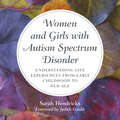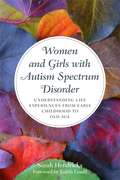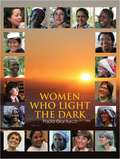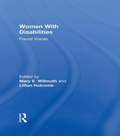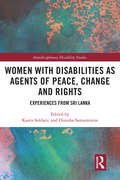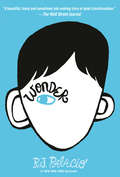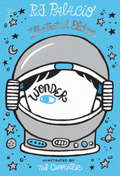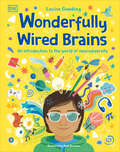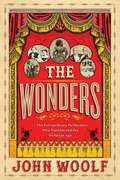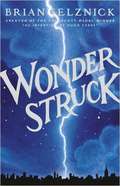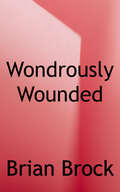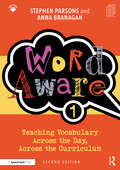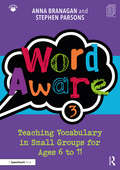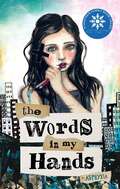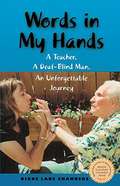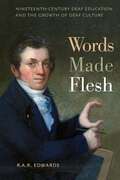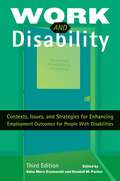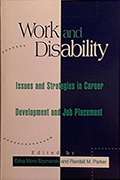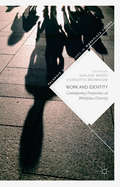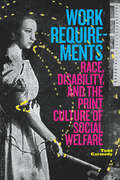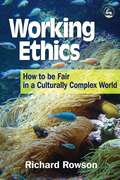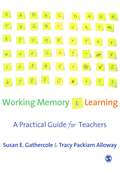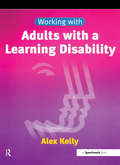- Table View
- List View
Women and Girls with Autism Spectrum Disorder: Understanding Life Experiences from Early Childhood to Old Age
by Sarah HendrickxA unique look at women and girls with Autism Spectrum Disorder.The difference that being female makes to the diagnosis, life and experiences of a person with an Autism Spectrum Disorder (ASD) has largely gone unresearched and unreported until recently. In this audiobook Sarah Hendrickx has collected both academic research and personal stories about girls and women on the autism spectrum to present a picture of their feelings, thoughts and experiences at each stage of their lives.Outlining how autism presents differently and can hide itself in females and what the likely impact will be for them throughout their lifespan, the audiobook looks at how females with ASD experience diagnosis, childhood, education, adolescence, friendships, sexuality, employment, pregnancy and parenting, and aging. It will provide invaluable guidance for the professionals who support these girls and women and it will offer women with autism a guiding light in interpreting and understanding their own life experiences through the experiences of others.(P) 2021 Jessica Kingsley Publishers
Women and Girls with Autism Spectrum Disorder: Understanding Life Experiences from Early Childhood to Old Age
by Sarah Hendrickx Judith GouldThe difference that being female makes to the diagnosis, life and experiences of a person with an Autism Spectrum Disorder (ASD) has largely gone unresearched and unreported until recently. In this book Sarah Hendrickx has collected both academic research and personal stories about girls and women on the autism spectrum to present a picture of their feelings, thoughts and experiences at each stage of their lives. Outlining how autism presents differently and can hide itself in females and what the likely impact will be for them throughout their lifespan, the book looks at how females with ASD experience diagnosis, childhood, education, adolescence, friendships, sexuality, employment, pregnancy and parenting, and aging. It will provide invaluable guidance for the professionals who support these girls and women and it will offer women with autism a guiding light in interpreting and understanding their own life experiences through the experiences of others.
Women Healers: Portraits of Herbalists, Physicians, and Midwives
by Elisabeth BrookeFrom antiquity to the present, women have been persecuted. In history, women midwives, healers and herbalists have been burned as witches, raped and tortured for their practices. More recently, women are threatened with sexual discrimination in the medical field in more covert ways. In this book, Elisabeth Brooke highlights women healers, herbalists, and midwives and shows them in both a historical sense, as well as a medical sense.
Women Who Light the Dark
by Paola GianturcoFrom Book Jacket: Across the world, local women are helping one another tackle the problems that darken their lives-domestic violence, sex trafficking, war, poverty, illiteracy, discrimination, inequality, malnutrition, disease. These women may lack material resources, but they possess a wealth of an even more precious resource: imagination. And their imaginations light the dark. Women in Morocco create and produce plays that educate illiterate people about women's rights. Girls in Zimbabwe compose and perform poetry that shocks communities into fighting child rape. Teachers in India invent puppet shows that help homeless children understand AIDS. Brazilian math teachers inspire girls from the favelas to learn arithmetic by originating fashion shows. Lesbians in Argentina develop and stage street skits, demonstrating against discrimination. A master ballet teacher instructs a thousand poor Cuban children in classical dance. Sometimes imagination takes the form of innovative strategies. In Nepal, women teach their sisters to drive taxis and guide treks, and in Nicaragua, to become welders, carpenters, and electricians-all supposedly men's jobs. In Kenya, mothers get wells dug so their daughters can go to school instead of walking seven hours to fetch water. In Cameroun, medical specialists train traditional rulers and healers whose behavior has inadvertently spread AIDS to become health educators. In the United States, activists introduce women with disabilities to challenge courses, camping, whitewater rafting, and swimming, empowering them to lead others who are disabled. Travel with photojournalist Paola Gianturco to fifteen countries on five continents. Hear, in the women's own words, about their lives and work. Sit on the floor talking with sex workers; climb Annapurna with burning lungs; ride in a taxi while political protesters are arrested just blocks away; eat lunch as soldiers carry sandbags to the roof and prepare for battle; watch a traditional healer at work; interview members of parliament; witness a ceremony that welcomes indigenous babies to the world. Above all, be inspired by the courage and creativity of effective women who are kindling hope and possibility for their families, communities, countries, and our world. (c) powerHouse Cultural Entertainment, Inc.
Women with Disabilities: Found Voices
by Mary E. Willmuth Lillian HolcombBoth women with disabilities and women professionals who work with persons with disabilities address many concerns about life with a disability and issues related to disability and psychotherapy. Annotation c. by Book News, Inc., Portland, Or.
Women with Disabilities as Agents of Peace, Change and Rights: Experiences from Sri Lanka (Interdisciplinary Disability Studies)
by Karen Soldatic and Dinesha SamararatneDrawing on rich empirical work emerging from core conflict regions within the island nation of Sri Lanka, this book illustrates the critical role that women with disabilities play in post-armed conflict rebuilding and development. This pathbreaking book shows the critical role that women with disabilities play in post-armed conflict rebuilding and development. Through offering a rare yet important insight into the processes of gendered-disability advocacy activation within the post-conflict environment, it provides a unique counter narrative to the powerful images, symbols and discourses that too frequently perpetuate disabled women’s so-called need for paternalistic forms of care. Rather than being the mere recipients of aid and help, the narratives of women with disabilities reveal the generative praxis of social solidarity and cohesion, progressed via their nascent collective practices of gendered-disability advocacy. It will be of interest to academics and students working in the fields of disability studies, gender studies, post-conflict studies, peace studies and social work.
Women's Moods: What Every Woman Must Know About Hormones, the Brain, and Emotional Health
by Deborah Sichel Jeanne Watson DriscollDiscusses the ways menstruation and pregnancy affect mood disorders in women.
Wonder
by R. J. PalacioI won't describe what I look like. Whatever you're thinking, it's probably worse. <P><P>August Pullman was born with a facial deformity that, up until now, has prevented him from going to a mainstream school. <P>Starting 5th grade at Beecher Prep, he wants nothing more than to be treated as an ordinary kid--but his new classmates can't get past Auggie's extraordinary face. <P><P>WONDER, now a New York Times bestseller, begins from Auggie's point of view, but soon switches to include his classmates, his sister, her boyfriend, and others. These perspectives converge in a portrait of one community's struggle with empathy, compassion, and acceptance. <P>In a world where bullying among young people is an epidemic, this is a refreshing new narrative full of heart and hope. R.J. Palacio has called her debut novel "a meditation on kindness" --indeed, every reader will come away with a greater appreciation for the simple courage of friendship. <P>Auggie is a hero to root for, a diamond in the rough who proves that you can't blend in when you were born to stand out.
Wonder: Illustrated Edition
by R. J. PalacioA beautiful, color illustrated edition of the #1 New York Times bestseller, Wonder, with a new afterword from the author. Experience the extraordinary story that inspired the Choose Kind movement, like never before.August Pullman was born with a facial difference that, up until now, has prevented him from going to a mainstream school. Starting 5th grade at Beecher Prep, he wants nothing more than to be treated as an ordinary kid--but his new classmates can't get past Auggie's extraordinary face. WONDER, now a #1 New York Times bestseller and a blockbuster hit, begins from Auggie's point of view, but soon switches to include his classmates, his sister, her boyfriend, and others. These perspectives converge in a portrait of one community's struggle with empathy, compassion, and acceptance. This beautiful, color illustrated edition includes over twenty-five pieces of original art from Tad Carpenter, the artist behind the original cover. It also includes an essay from R.J. Palacio reflecting on ten years of Wonder and an introduction by Dina Zuckerberg, director of family programs at myFace, a non-profit dedicated to supporting the craniofacial difference community. Experience this extraordinary story like never before.
Wonderfully Wired Brains: An Introduction to the World of Neurodiversity
by Louise GoodingAn informative and inclusive children&’s guide to neurodiversity for those not in the know and to inspire children who are neurodivergent.Our brains are unique in the way they function, work, and think. Neurodiversity is still a relatively &’new&’ concept that can be tricky to understand, but this book is here to help! This inspirational book written by neurodiverse author Louise Gooding challenges misconceptions and shows how neurodivergent brains work a little differently. It is common for neurodiverse people and those with neurological differences to feel as though they don&’t fit in, but their extraordinary differences should be embraced. Wonderfully Wired Brains teaches children aged 7-9 all about the awesome abilities that neurodiverse individuals have, introduces them to advocates who are challenging neurodiversity stereotypes, and most importantly gives them a safe space to feel accepted.This informative and educational book for children features: - Accurate, understandable explanations of diagnoses that impact the brain, including each area of neurodiversity and what it can or does mean for anyone with that particular neurological difference.- A positive, friendly look at neurodiverse brains that debunks myths and stereotypes.- Informative, inclusive text is accompanied by colorful, modern illustrations.- The font and colors used have been selected to accommodate a range of neurodiverse readers.Combining neurodiverse experiences with science, history, and brain-bursting facts, Wonderfully Wired Brains has something for everyone! Whether your child is neurodiverse or not, this book will inspire inquisitive young readers and show them that no two brains function in the same way and that everyone&’s differences should be celebrated. There really is no other book like it.
The Wonders: The Extraordinary Circus Performers Who Transformed The Victorian Age
by John WoolfA radical new history that rediscovers the remarkable freak performers whose talents and charisma helped define an era. On March 23, 1844, General Tom Thumb, just 25 inches tall, entered the Picture Gallery at Buckingham Palace and bowed low to Queen Victoria. On both sides of the Atlantic, this meeting marked a tipping point in the nineteenth century, and the age of the freak was born. Bewitching all levels of society, it was a world of curiosities and astonishing spectacle—of dwarfs, giants, bearded ladies, Siamese twins, and swaggering showmen. But the real stories—human dramas that so often eclipsed the fantasy presented on the stage—of the performing men, women and children, have been forgotten or marginalized in the histories of the very people who exploited them. In this richly evocative account, John Woolf uses a wealth of recently discovered material to bring to life the sometimes tragic, sometimes triumphant, always extraordinary stories of people who used their (dis)abilities and difference to become some of the first international celebrities. Through their lives we discover afresh some of the great transformations of the age: the birth of show business, of celebrity, of advertising, and of “alternative facts” while also exploring the tensions between the power of fame, the impact of exploitation, and our fascination with “otherness.”
Wonderstruck
by Brian SelznickFrom Brian Selznick, the creator of the Caldecott Medal winner THE INVENTION OF HUGO CABRET, comes another breathtaking tour de force.<P><P> Playing with the form he created in his trailblazing debut novel, The Invention of Hugo Cabret, Brian Selznick once again sails into uncharted territory and takes readers on an awe-inspiring journey.<P> Ben and Rose secretly wish their lives were different. Ben longs for the father he has never known. Rose dreams of a mysterious actress whose life she chronicles in a scrapbook. When Ben discovers a puzzling clue in his mother's room and Rose reads an enticing headline in the newspaper, both children set out alone on desperate quests to find what they are missing.<P> Set fifty years apart, these two independent stories--Ben's told in words, Rose's in pictures--weave back and forth with mesmerizing symmetry. How they unfold and ultimately intertwine will surprise you, challenge you, and leave you breathless with wonder. Rich, complex, affecting, and beautiful--with over 460 pages of original artwork--Wonderstruck is a stunning achievement from a uniquely gifted artist and visionary.<P> Winner of the Schneider Family Book Award
Wondrously Wounded: Theology, Disability, and the Body of Christ
by Brian BrockThe church welcomes all―or it should. <p><p> The church has long proven itself a safe refuge despite the sad reality that it can be, and has been, unwelcoming toward those perceived as different. This is especially true of the contemporary church’s response to those with disabilities―a response often at surprising variance with its historic practices of care. The church once helped shape western morality to cherish these individuals with love and acceptance. It is thus ironic when today’s church neglects this care, or practices care with no awareness of the rich theological history out of which such moral sensibilities originally emerged. In Wondrously Wounded, Brian Brock reclaims the church’s historic theology of disability and extends it to demonstrate that people with disabilities, like all created in God’s image, are servants of God’s redemptive work. <p><p> Brock divides his volume into five parts. Part one chronicles how early Christianity valued and cared for those with disabilities, putting into practice Jesus’ teachings about divine mercy in decidedly countercultural ways. Part two details how a rise in the fear of disability tempted the church away from these merciful practices as well as its confession of the infinite worth of all God has created. Part three traces how the fear of difference continues to negatively shape contemporary practices in today’s schools, churches, and politics. Part four lays the foundations of a vision of Christian life that is resistant to this pervasive fear. Finally, Part five shows how the recognition of all people as part of the body of Christ not only demonstrates the love of Christ but displaces the fear of disability in a manner that invites the church beyond even the most ambitious contemporary hopes for full inclusion. <p><p> Brock interweaves his historical and theological analysis with the narrative of his own disabled son, Adam. These stories vividly bring into view the vulnerability, as well as the power, of the disabled in contemporary society. Ultimately, Brock argues, those with disabilities are conduits of spiritual gifts that the church desperately needs. Wondrously Wounded is an appeal to the church to find itself broken and remade by the presence of Christ on offer in the lives of those society has labeled "disabled."
Word Aware 1: Teaching Vocabulary Across the Day, Across the Curriculum
by Stephen Parsons Anna BranaganNow in a fully updated second edition, this comprehensive and practical book outlines the theoretical underpinnings for vocabulary and acts as a ‘how to’ guide to developing word learning across the school and curriculum. It is packed with easy-to-implement activities, worksheets and resources that can be put into practice immediately with individual students or groups, whole classes and throughout the school. The Word Aware approach provides a structured framework to promote vocabulary development in all children and has been rigorously tried and tested. Now in full colour, with photocopiable and downloadable materials, it is an outstanding resource that will be an essential addition to any school and classroom. The second edition of Word Aware 1 brings: An even wider range of ready-to-go vocabulary activities Fine-tuned teaching techniques Enhanced resources to develop children’s independent word learning skills A step-by-step guide to developing a whole school approach Word Aware 1 is an invaluable tool for teachers and other professionals looking to support children as they broaden their vocabulary. It is particularly suited to children aged 5–11 years but can easily be adapted for older children.
Word Aware 3: Teaching Vocabulary in Small Groups for Ages 6 to 11
by Anna Branagan Stephen ParsonsWord Aware 3 is a comprehensive, practical and engaging resource that focuses on teaching vocabulary and word learning skills to children aged 6 to 11 years who have vocabulary learning needs. For many children, particularly those with Special Educational Needs and Disabilities (SEND) or those whose home language isn’t English (ELL or EAL learners), the vocabulary of the classroom can be a barrier to learning. This book outlines how to best support these children who require extra help, offering concrete, easy-to-implement activities and resources for use in small groups, to maximise the impact on learning and open up access to the curriculum. Word Aware 3: Takes a highly practical, evidence-based and curriculum-focused approach to vocabulary learning that supports a broad range of learners Includes photocopiable and downloadable planning, intervention and evaluation resources Provides staff training resources and an overview video presented by the authors This book can be used as an adjunct to Word Aware 1, or as an intervention on its own. Although it is most suited to children aged 6 to 11 years, it may be adapted for older students with significant learning needs. It is an essential resource for teaching assistants and learning support assistants and will also save time for special educational needs co-ordinators (SENCOs) and speech and language therapists (SaLTs) who are keen to establish effective vocabulary interventions.
The Words in My Hands
by AsphyxiaPart coming of age, part call to action, this fast-paced #ownvoices novel about a Deaf teenager is a unique and inspiring exploration of what it means to belong. <p><p> Set in an ominously prescient near future, The Words in My Hands is the story of Piper: sixteen, smart, artistic, and rebellious, she’s struggling to conform to what her mom wants—for her to be ‘normal,’ to pass as hearing, and get a good job. But in a time of food scarcity, environmental collapse, and political corruption, Piper has other things on her mind—like survival. <p><p> Deaf since the age of three, Piper has always been told that she needs to compensate in a world that puts those who can hear above everyone else. But when she meets Marley, a whole new world opens up—one where Deafness is something to celebrate rather than hide, and where resilience and hope are created by taking action, building a community, and believing in something better. <p><p> Published to rave reviews as Future Girl in Australia (Allen & Unwin, Sept. 2020), this unforgettable story is told through a visual extravaganza of text, paint, collage, and drawings that bring Piper’s journey vividly to life. Insightful, hopeful, and empowering, The Words in My Hands is very much a novel for our turbulent times.
Words in My Hands: A Teacher, A Deaf-Blind Man, An Unforgettable Journey
by Diane ChambersBert Riedel, an 86-year-old deaf-blind pianist, cut off from the world since age 45, discovers a new life through hand-over-hand sign, taught to him by the author.
Words Made Flesh: Nineteenth-Century Deaf Education and the Growth of Deaf Culture (The History of Disability #4)
by R. A. EdwardsDuring the early nineteenth century, schools for the deaf appeared in the United States for the first time. These schools were committed to the use of the sign language to educate deaf students. Manual education made the growth of the deaf community possible, for it gathered deaf people together in sizable numbers for the first time in American history. It also fueled the emergence of Deaf culture, as the schools became agents of cultural transformations.Just as the Deaf community began to be recognized as a minority culture, in the 1850s, a powerful movement arose to undo it, namely oral education. Advocates of oral education, deeply influenced by the writings of public school pioneer Horace Mann, argued that deaf students should stop signing and should start speaking in the hope that the Deaf community would be abandoned, and its language and culture would vanish. In this revisionist history, Words Made Flesh explores the educational battles of the nineteenth century from both hearing and deaf points of view. It places the growth of the Deaf community at the heart of the story of deaf education and explains how the unexpected emergence of Deafness provoked the pedagogical battles that dominated the field of deaf education in the nineteenth century, and still reverberate today.
Work and Disability: Contexts, Issues, and Strategies for Enhancing Employment Outcome for People With Disabilities (Third Edition)
by Edna Mora Szymanski Randall M. Parker<p>Work is a central aspect of human life in every culture and every society. In certain societies work may be a means by which individuals define themselves and/or maintain their quality of life. However, as a whole, work is the essential means by which we all attain our basic needs such as food and water. <p>In our modern society, persons with disability face a society in which jobs and education are not as easily accessible or attainable. Disability often complicates the delicate interrelationships between people and work. It may affect work productivity, relationships with coworkers, and relationships at home. <p>This third edition covers the latest in legislative background and other contextual matters regarding employment of people with disabilities; vocational theories and research related to disability; counseling interventions, multicultural issues, vocational assessment, labor market information, and accommodation of people with disabilities in the workplace; job placement and job development; outreach through business consultation; and supported employment for individuals with developmental disabilities.</p>
Work and Disability: Issues and Strategies in Career Development and Job Placement
by Edna Mora Szymanski Randall M. ParkerProvides an overview of the context, theories, resources, and strategies for promoting the employment of people with disabilities. Looks at psychosocial and economic aspects of work, legislation, occupational and labor market information, the business perspective, and supporting employment.
Work and Identity: Contemporary Perspectives On Workplace Diversity (Palgrave Explorations In Workplace Stigma Ser.)
by Shalene Werth Charlotte BrownlowThis edited volume highlights relevant issues and solutions for diversity groups within the workplace. It explores issues of identity as they relate to attributes of gender, age, migrant labor, disability, and power in social spaces. Identity is rarely well-defined in many social spaces, and understandings that define belonging are often developed through the normative expectations of others. Having an evidence-based approach in addressing these relevant issues, this book will appeal to academics and practitioners alike looking for practical and theoretical solutions to improving the situations of these groups in paid employment.
Work Requirements: Race, Disability, and the Print Culture of Social Welfare
by Todd CarmodyThroughout the history of the United States, work-based social welfare practices have served to affirm the moral value of work. In the late nineteenth century this representational project came to be mediated by the printed word with the emergence of industrial print technologies, the expansion of literacy, and the rise of professionalization. In Work Requirements Todd Carmody asks how work, even the most debasing or unproductive labor, came to be seen as inherently meaningful during this era. He explores how the print culture of social welfare—produced by public administrators, by economic planners, by social scientists, and in literature and the arts—tasked people on the social and economic margins, specifically racial minorities, incarcerated people, and people with disabilities, with shoring up the fundamental dignity of work as such. He also outlines how disability itself became a tool of social discipline, defined by bureaucratized institutions as the inability to work. By interrogating the representational effort necessary to make work seem inherently meaningful, Carmody ultimately reveals a forgotten history of competing efforts to think social belonging beyond or even without work.
Working Ethics: How to Be Fair in a Culturally Complex World
by Richard RowsonWorking Ethics sets out an ethical foundation for professionals and for the professions in a modern, culturally complex society. This book will be of interest to anyone who takes seriously their obligations to society as a whole and to the individuals with whom they work. Richard Rowson puts forward an ethical framework comprising four basic elements - fairness, respect for autonomy, integrity, and seeking the most beneficial and least harmful consequences. The three parts of the book explore: * sources of ethical guidance such as laws, social conventions, professional codes of conduct and religious beliefs, identifying the ethical values integral to the professions * the obligations these values give to members of the professions, and the ethical issues which arise when they are concerned to produce benefits and prevent harm, treat people fairly, respect others and act with integrity * how these values might be incorporated into professional practice. The book ends with a brief guide to dealing with blame in a professional context and claims about rights. At the end of each chapter, key questions encourage readers to think through the issues discussed. Rowson shows how this ethical framework can enable professionals to work more effectively, earn trust, mutual support and respect, and how it can foster democratic ideals in the workplace and community. This book will be essential reading for professionals in the public and private sector - including teachers, civil servants, police personnel, nurses, doctors, lawyers, accountants and engineers.
Working Memory and Learning: A Practical Guide for Teachers
by Susan E. Gathercole Tracy Packiam AllowayDr Tracy Alloway has been awarded the prestigious Joseph Lister Award from the British Science Association. 'The authors have written a guide for practitioners that is both highly practical, and yet based upon sound theoretical principles…. This book achieves a successful, yet often elusive, link between theory, research and practice, and deserves to have a high readership. I will have no hesitation in recommending it to a range of readers' - Jane Mott, Support for Learning 'This book fulfils its aim to explain working memory and the limits it places on children's classroom learning. For teachers it gives a very clear guide and fills a gap in understanding that can only lead to more child-centred approaches to teaching and learning' - Lynn Ambler, Support for Learning 'A clear and accessible account of current theory and research, which is then applied to children's learning in the classroom. . . . The range of strategies. . . are well grounded in theory derived from research and sit within a coherent conceptual model' - The Psychologist 'An easy to read yet informative book that explains the concepts clearly and offers practitioners ways to support those with poor working memory in the classroom' - SNIP `The topic of working memory nowadays tends to dominate discussions with teachers and parents, and both groups can helpfully be directed to this easy-to-read but serious text … (it) is likely to prove a turning-point in the management and facilitation of hard-to-teach children. In a situation muddied by ever-multiplying syndromes and disorders, this book delivers a clarifying and reassuring isolation of the major cognitive characteristic that cuts across all the boundaries and leaves the class teacher and SENCO empowered. I think very highly of the book and shall be recommending it steadily' - Martin Turner, Child Center for Evaluation and Teaching, Kuwait Susan Gathercole is winner of the British Psychological Society's President's Award for 2007 A good working memory is crucial to becoming a successful learner, yet there is very little material available in an easy-to-use format that explains the concept and offers practitioners ways to support children with poor working memory in the classroom. This book provides a coherent overview of the role played by working memory in learning during the school years, and uses theory to inform good practice. Topics covered include: - the link between working memory skills and key areas of learning (such as literacy & numeracy) - the relationship between working memory and children with developmental disorders - assessment of children for working memory deficits - strategies for supporting working memory in under-performing children This accessible guide will help SENCOs, teachers, teaching assistants, speech and language therapists and educational psychologists to understand and address working memory in their setting.
Working with Adults with a Learning Disability (Working With Series)
by Alex KellyA comprehensive and practical resource for all speech and language therapists and students, this book covers all aspects of working with this client group. Written by the author of the hugely successful "Talkabout", each section gives the reader a theoretical background of the subject under discussion, practical suggestions and formats for assessment, a guide to intervention as well as a clear and worked-out example. In addition, the author addresses staff training, group therapy, accessing the criminal justice system and working with a multi-disciplinary team.
